All photography © 2005-2010 Greg Allikas
G.C.K. Dunsterville offers the following brief description of this species in a 1980 article which appeared in the A.O.S. Bulletin, and later in book form as a collection of his A.O.S. Bulletin articles.
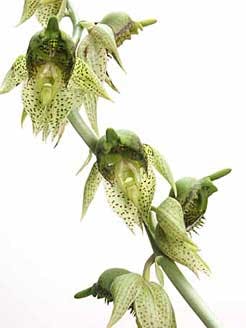
Our plant of Catasetum sanguineum flowering last year. The distinctive feature that first struck me was the nose-like projection from the apex of the lip. In some views it resembles a bird's beak.
Dodson's Catasetum definition is that a catasetum should have a pollinia-ejecting mechanism based on sensitive projections from the side of the column. These are commonly in the form of slender, antenna-like things, so placed that they guard the entrance to the hollow part of the base of the lip; and a division of the genus has been proposed, based on whether these antennae are bashfully crossed (or one even curled up behind the other), or run parallel to each other (or even lightly spread apart). The bashful ones form the Anisoceras Section¹, the others the Isoceras Section. The orchids previously dealt with in this note (Ctsm. pileatum, splendens, macrocarpum) are all anisocerases, if one may coin such a word. Catasetum sanguineum and Catasetum costatum, are isocerases.
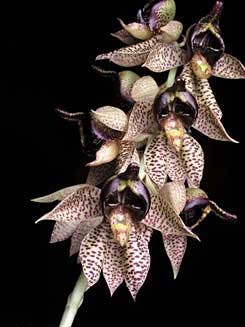
A fine awarded example of the dark, or sanguine, color form: Catasetum sanguineum 'Kiaora' AM/AOS, grown by Georgia Tasker and Sandy Schultz.
The moderately rare Catasetum sanguineum is to be found in the east or east-central part of the northern section of Venezuela and also in the extreme west where it lives in the low country between Lake Maracaibo and the Perija range that here forms the border with Colombia. From here it ranges further north to Costa Rica and west to Ecuador. The inflorescences vary from suberect to arching, and bear a dense, generally rather few-flowered raceme at the end of a ten-inch peduncle. In line with its sanguine name, the two-inch flowers of Catasetum sanguineum are mainly red and are characterized by a very interesting and complicated lip with a deeply cup-shaped base overhung by fimbriate, lateral lobes and ending in a very thick, apical lobe which is sometimes wide and spade-like and in other flowers may be narrow and pointed.
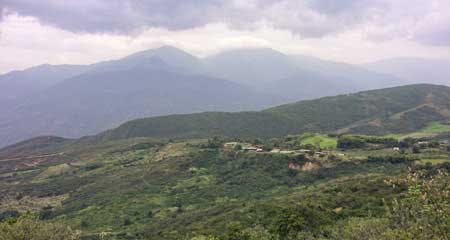
The catasetums were found growing in a thicket across the road behind me.
As I sit writing this on the third day of September, our plant is about a week away from opening its greenish flowers. The World Checklist of Monocotyledons shows two varieties of Catasetum sanguineum: var. sanguineum and var. viride. While these names apparently represent the red and green color forms, the species may be more variable than either suggests and there are plants that produce flowers intermediate between the two, some seemingly bi-colored with greenish sepals and petals and a red-brown lip. Dunsterville's drawing shows not only an arching inflorescence, but also a single resupinate flower. He states the inflorescence to be "suberect to arching" in his description above. None of the plants that I have seen, nor any of the photographs I find on the internet display anything other than an erect inflorescence so his obeservation may be based on the light/culture his reference plants received, or if studying wild plants, the sheer mechanics of pushing a flower spike through the dense bramble in which the species can be found.
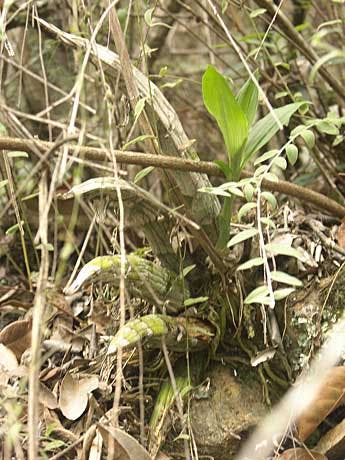
Here a plant of Ctsm. sanguineum is growing on rocks and leaf litter in the filtered light below woody shrubs.
I saw this species growing near Humocaro Alto in Venezuela, in a dense, shrubby thicket along a roadside overlooking a valley. The plants were growing hemi-terrestrially in leaf litter with the roots extending down into the clay topsoil. In March, the plants were well into new growth but had not yet initiated new roots. Even at our altitude here (about 900m/3000ft), this close to the equator growth cycles in catasetums are triggered by wet-dry seasons more than temperature or day length. In March, root growth was just beginning in anticipation of the start of the rainy season. By that time there would be enough roots to use the moisture that would arrive in abundance.
We grow Catasetum sanguineum in a plastic pot using New Zealand sphagnum moss as a media. A few chunks of charcoal or styrofoam (you can use washed landscape-grade river rock for better stability of the pot on a flat surface) are placed in the bottom of the pot and then the moss is added around whatever roots we have left. The media should be neither too tight or too loose, but firm enough to help anchor the plant, yet still springy. If you have divided a plant and have one or two rootless pseudobulbs, a straight or ring stake should be used to stabilize the pseudobulbs. Don't allow the newly potted plant to wobble. The fat pseudobulbs of a catsetum can sustain a plant without water for several months so do not be in a hurry to begin watering them early in their growth cycle. Read the last two sentences in the preceding paragraph again. Wait until growth is several inches high and new roots have extended two or more inches into the media. Watering catasetums too early in their growth cycle can result in new leads rotting away. Should you experience that unfortunate situation don't despair. These plants are survivors and will often develop new leads from nodes midway up the pseudobulb.
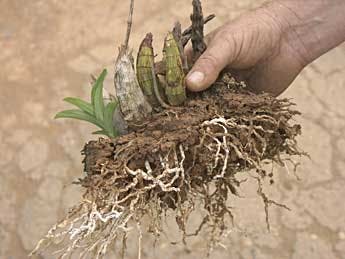
In March, new growths were well under way but plants had not begun growing roots. Note how last year's roots extend down in to the clay substrate.
By early summer new growth should be well under way and a short-season vegetable garden approach is called for. These are greedy feeders and during their growing season should be kept moist and well fed. We use a balanced time release fertilizer as a top dressing and feed plants weekly with liquid fertilizer along with the other orchids. After Ctsm. sanguineum finishes flowering water is reduced slightly for a few weeks. Then we gradually decrease watering until we see our first cool weather. Here in South Florida that is usually between Halloween and Thanksgiving. When the weather turns decidely winter, we move the plants under cover and allow them to dry completely.
Being deciduous orchids, the leaves will drop when plants go dormant. In years past, some growers would actually unpot the plants, trim all the roots, and set them on a dry bench until roots appeared in the spring. We do not practice such a severe regimen and simply allow the plants to experience a dry and cool winter. If it looks like the newest bulbs are shriveling we will pass a hose over the pot without soaking the media. As spring nears, we may repeat that process more frequently especially as the growths emerge, being careful to not get water in the tender new leafy growth. But this is just a passing of the water wand, not a thorough watering. Leafless Catsetum pseudobulbs can withstand freezing temperatures without damage but of course, you do not want to allow the bulbs themselves to freeze. So a safer bet would be to try to not allow dormant bulbs to experience temperatures below the 40-45º F range.
Whether you decide to grow plants on to multi bulb specimens or divide them yearly is up to you, but we do not leave plants in the same media for more than two years. Ctsm. sanguineum is adaptable to a wide range of light intensities and somewhere between 2000-3000 foot candles is probably about optimum. Filtered to bright light as indicated on our light chart will do. Brighter light tends to produce female flowers in many catasetums so if you wish to see male flowers, move the plant to a shadier location as soon as you see a flower spike emerge. Temperature range during the growing season should be intermediate, 70-80º F daytime and 55-65º F nights. Here in Florida we grow the plants somewhat warmer and they do fine.
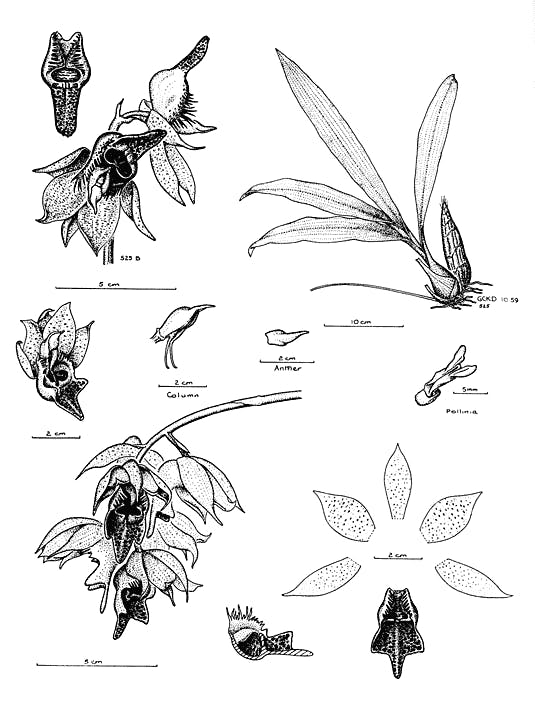
1) The etymology of "Anisoceras" is: An- meaning without, iso- meaning same, and -ceras meaning horns because the 2 antennae are not alike. Whereas "Isoceras" refers to: Iso- meaning same and -ceras meaning horns because their 2 antennae are alike. Thanks to Eric A. Christenson, Ph.D. for this explanation.
References
Dunsterville, G.C.K. and E. 1988. Orchid Hunting in The Lost World (And Elsewhere in Venezuela). The American Orchid Society. West Palm Beach
Greg Allikas - September 2010









